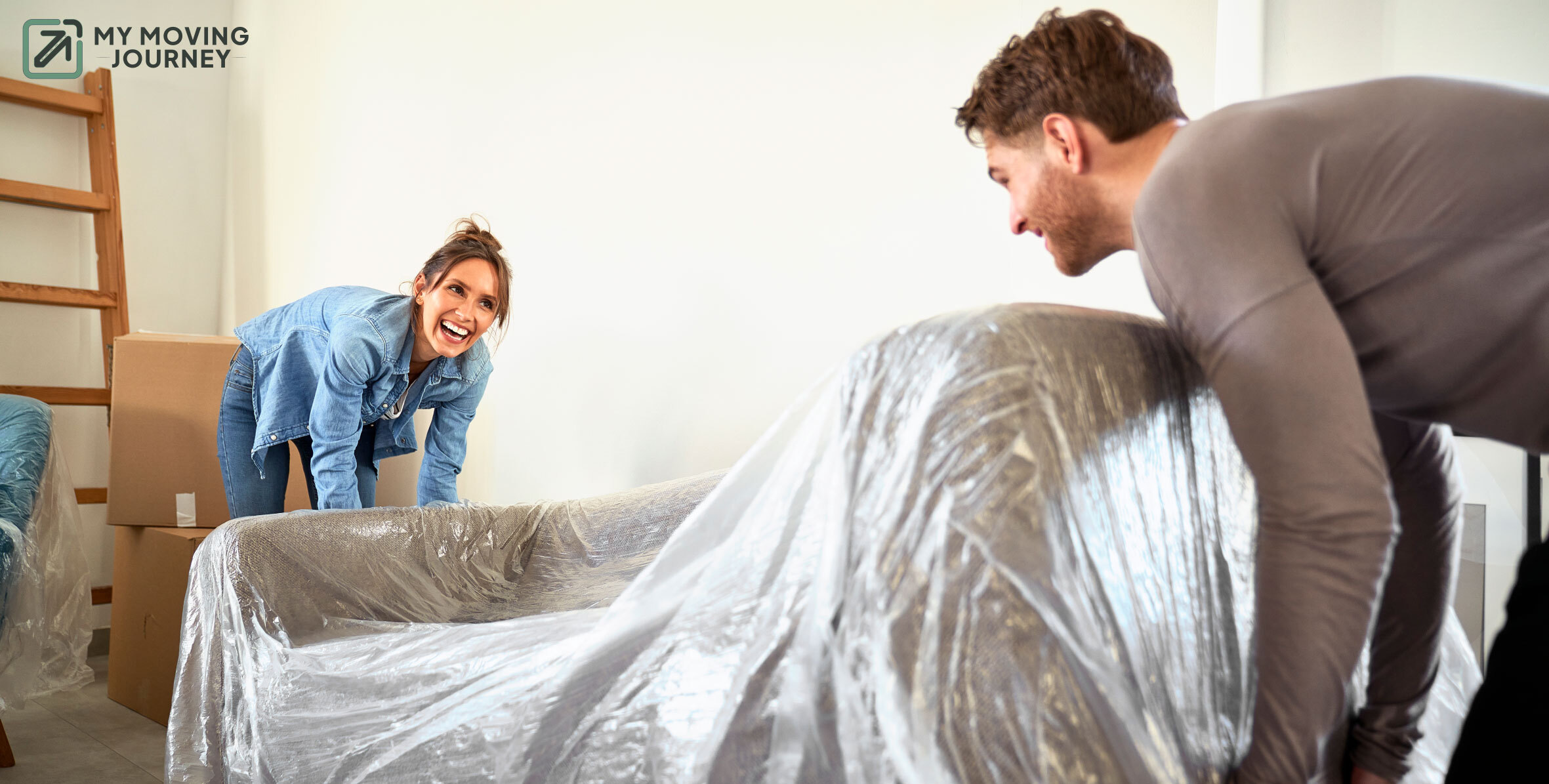An ounce of prevention is worth a pound of cure.
When it comes to moving, this old saying couldn't be more relevant, especially when we talk about using plastic wrap for moving. It’s not just about packing boxes and hoping your belongings arrive safely—it’s about smartly securing and protecting your valuables to minimize damage, effort, and stress.

More than 31 million Americans move each year. That’s roughly 10% of the U.S. population relocating annually, whether for jobs, family, or new opportunities.
And with moving being one of the most stressful life events (ranked right up there with divorce and job loss), it’s crucial to take steps that can ease the process. Packing and protecting your items the right way is one of those steps.
One often overlooked but incredibly effective tool in your moving arsenal is plastic wrap. Plastic wrap is versatile, affordable, and protective, making it ideal for everything from securing furniture to bundling up those awkwardly shaped items.
Many people don’t realize how much this simple tool can reduce the stress of moving. Imagine your dresser drawers staying shut in transit or your couch is protected from dirt and moisture.
In fact, professional movers frequently use plastic wrap, not just because it's effective but also because it's cost-efficient.
For a small investment—typically around $20 for a 1500-foot roll—you can safeguard thousands of dollars worth of furniture and belongings.
And with the cost of moving already running an average of $1,400 to $2,300 for local moves, any tool that offers such a return on investment is worth considering.
Let’s talk about how to use plastic wrap, why it's such a game-changer and the tips and tricks that can make your move smoother.
What is Plastic Wrap and Why Use It for Moving?
Plastic wrap, also known as stretch wrap or shrink wrap, is a transparent, clingy plastic film that’s perfect for securing and protecting your belongings during a move. It's incredibly versatile, durable, and inexpensive, making it a go-to packing material for moving all sorts of items—from furniture to fragile items.
One of the main reasons to use plastic wrap is its tear-resistance and clingy nature. Unlike packing tape or other materials, it sticks to itself without leaving any residue behind, meaning your furniture and other valuables will remain clean and intact after removal. Whether you are bundling furniture parts together or protecting your sofa from dirt, plastic wrap does it all.
Step-by-Step: How to Use Plastic Wrap for Moving
Here’s how you can best use plastic wrap for moving:
- Clean and Disassemble: Start by cleaning your items thoroughly. Dirt and grime can get trapped under the wrap, which could potentially cause damage. For furniture, disassemble parts like shelves, legs, or glass doors to make wrapping easier.
- Add Padding: If you’re wrapping furniture, make sure to cover any sharp edges or delicate parts with padding. Use bubble wrap or foam padding for corners, especially for wooden items. Once the padding is in place, the plastic wrap will secure it.
- Wrap Securely: Hold the roll of plastic wrap with your fingers inside and walk around the item. Wrap horizontally from bottom to top, creating tight, overlapping layers. This ensures every part is well-secured.
- No Tape Needed: Once you’ve wrapped the item sufficiently, you don’t need tape to hold the wrap in place. The plastic wrap clings to itself, creating a tight seal.
Plastic Wrap vs. Bubble Wrap for Moving
Both plastic wrap and bubble wrap have their uses, but which one is better for your move?
Both have their strengths, but they serve distinct purposes during a move.
| Feature | Plastic Wrap | Bubble Wrap |
|---|---|---|
| Primary Use | Best for securing items and preventing them from shifting. | Ideal for cushioning fragile items like dishes, glasses, or electronics to protect them from impact. |
| Protection | Provides protection against dirt, dust, and moisture. It’s perfect for protecting furniture from scuffs or water damage. | Offers excellent protection against shock and breakage. The air-filled bubbles act as a buffer for delicate items. |
| Adhesion | Plastic wrap clings to itself, so you don’t need any additional adhesive or tape to secure it around an object. | Bubble wrap requires tape to secure it in place, especially around oddly shaped items. Without tape, it may come loose. |
| Durability | Extremely tear-resistant and stretchy, making it strong enough to secure bulky furniture. | While it provides great shock absorption, bubble wrap is more prone to punctures and doesn’t handle sharp objects as well. |
| Ease of Use | Quick and easy to use. Simply wrap and go—no complicated folding or taping required. | Takes a bit more time to cut, tape, and fit properly, especially if the object has irregular shapes. |
| Cost | Very affordable, with a roll of plastic wrap (20” x 1500 ft) costing around $20. | Bubble wrap can be pricier. Depending on the size of the bubbles (small or large), a roll could cost between $10 and $30. |
| Environmental Impac | Can be recycled, but it’s important to check local recycling programs. | Bubble wrap is typically made from non-biodegradable plastic, and it can sometimes be recycled. |
Which One Should You Choose?
If you're looking to secure furniture, cords, or movable parts, plastic wrap is your best bet. It's cost-effective and does an excellent job of holding things in place. On the other hand, if you have fragile items—especially glassware or electronics—you’ll want to invest in bubble wrap for its superior cushioning.
In fact, household goods claims due to damage are highest for fragile items like electronics, which reinforces the need for the extra protection bubble wrap offers.
The best approach is to combine both. Use plastic wrap to secure furniture and hold everything in place, and use bubble wrap for breakables to give them the shock protection they need. This will maximize the protection of your belongings while keeping costs in check.
How Much Plastic Wrap Do You Need for Moving?
| Item | Estimated Plastic Wrap Needed | Notes |
|---|---|---|
| Sofa (3-Seater) | 75-100 feet | You'll need to wrap around the entire sofa, focusing on the arms, cushions, and bottom to protect it from dirt. |
| Queen Size Mattress | 50-75 feet | Ideal for protecting against dust and moisture. Wrap tightly for a secure fit. |
| Dresser (with Drawers) | 100-150 feet | Secure drawers and handles. Use extra wrap if the dresser is tall or has detachable parts like mirrors. |
| Dining Table | 75-100 feet | Remove the legs and wrap them separately. Focus on wrapping corners and tabletop for protection from scratches. |
| Refrigerator | 150-200 feet | Wrap doors and handles to keep them shut. Also, wrap shelves if they are not removable. |
| Television (Flat Screen) | 50-75 feet | Use bubble wrap first for cushioning, then secure it with plastic wrap. |
| Bookshelves | 75-100 feet | Ensure shelves are wrapped separately if they are detachable. Protect edges and corners carefully. |
| Coffee Table | 50-75 feet | Wrap the legs and top separately. Use extra wrap for glass-topped tables to avoid damage. |
| Office Chair | 25-50 feet | Wrap arms, seats, and wheels securely to avoid damage during transport. |
| Box of Fragile Items | 20-30 feet (per box) | Use plastic wrap to bundle items like glassware, plates, and electronics within the box and secure the padding. |
Why Do These Estimates Matter?
Plastic wrap is stretchy, but you’ll want to make sure you apply enough layers, especially around sensitive parts like edges, corners, and delicate surfaces. For large furniture or appliances, expect to use multiple layers, especially if you're protecting from dirt, moisture, or minor bumps during transport.
A good rule of thumb is that for an average two-bedroom home, you’ll need around 1000-1500 feet of plastic wrap, depending on how much furniture you have and how thorough you want to be in your protection(
By using the above table as a guide, you’ll be able to buy the right amount of plastic wrap for your move, saving time, money, and frustration!
How Much Does It Cost to Use Plastic Wrap For Moving
This is a handy tool for protecting your items, and while it can be a bit of an investment, it’s generally worth it for the added protection and organization it offers.
Here’s a general idea of what you might expect in terms of costs:
1. Cost of Plastic Wrap Roll
- Small Roll (12” x 1500’): $10 - $20
- Medium Roll (18” x 1500’): $15 - $30
- Large Roll (24” x 1500’): $25 - $45
2. Cost of Additional Supplies
- Cutting Tool: $5 - $15
- Packing Tape: $3 - $10 per roll
- Bubble Wrap: $10 - $30 per roll
3. Total Estimated Cost
Here’s a simplified table of the estimated total cost based on different sizes of plastic wrap rolls:
| Roll Size | Cost of Roll | Cutting Tool | Packing Tape | Bubble Wrap | Total Cost (Approx.) |
|---|---|---|---|---|---|
| 12” x 1500’ | $10 - $20 | $5 - $15 | $3 - $10 | $10 - $30 | $28 - $75 |
| 18” x 1500’ | $15 - $30 | $5 - $15 | $3 - $10 | $10 - $30 | $33 - $85 |
| 24” x 1500’ | $25 - $45 | $5 - $15 | $3 - $10 | $10 - $30 | $43 - $100 |
Different Types of Plastic Wrap and Their Costs
There are several types of plastic wrap available, each with its own price range and characteristics:
| Type of Wrap | Description | Cost per Roll (Approx.) |
|---|---|---|
| Standard Wrap | Basic plastic wrap, good for general use. | $10 - $20 |
| Heavy-Duty Wrap | Thicker and stronger, ideal for heavier items. | $20 - $40 |
| Pre-Stretched Wrap | Pre-stretched for ease of use, less effort required. | $15 - $35 |
| Colour-Coded Wrap | Comes in different colors for easy identification. | $20 - $45 |
Additional Considerations
- Quantity Needed: Depending on the size of your move, you might need more than one roll. A small apartment might only need one roll, while a large house might require several.
- Bulk Purchasing: Sometimes, buying in bulk or from moving supply companies can save money. Look for bulk discounts or bundle deals.
- Rental Options: If you don’t want to buy plastic wrap, consider renting it from moving companies. This can be a cost-effective option for short-term needs.
- DIY vs. Professional Help: If you’re hiring professional movers, check if plastic wrap is included in their services or if you’ll need to supply it yourself.
Moving with Plastic Wrap: Tips and Tricks
Here are a few tips to make moving with plastic wrap even easier:
- Use wider rolls (15-22 inches): A wider roll will help cover large pieces of furniture more efficiently, reducing the number of layers you need(
- Use multiple layers: Don’t be afraid to wrap items multiple times, especially for items prone to damage. This will create a thicker protective barrier(
- Skip the tape: One of the major advantages of plastic wrap is that it sticks to itself, so there's no need for additional tape. However, if needed, you can use tape to secure padding materials like foam before applying the plastic wrap.






